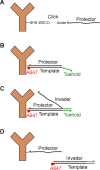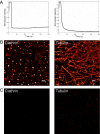Sequential super-resolution imaging using DNA strand displacement
- PMID: 30169528
- PMCID: PMC6118358
- DOI: 10.1371/journal.pone.0203291
Sequential super-resolution imaging using DNA strand displacement
Abstract
Sequential labeling and imaging in fluorescence microscopy allows the imaging of multiple structures in the same cell using a single fluorophore species. In super-resolution applications, the optimal dye suited to the method can be chosen, the optical setup can be simpler and there are no chromatic aberrations between images of different structures. We describe a method based on DNA strand displacement that can be used to quickly and easily perform the labeling and removal of the fluorophores during each sequence. Site-specific tags are conjugated with unique and orthogonal single stranded DNA. Labeling for a particular structure is achieved by hybridization of antibody-bound DNA with a complimentary dye-labeled strand. After imaging, the dye is removed using toehold-mediated strand displacement, in which an invader strand competes off the dye-labeled strand than can be subsequently washed away. Labeling and removal of each DNA-species requires only a few minutes. We demonstrate the concept using sequential dSTORM super-resolution for multiplex imaging of subcellular structures.
Conflict of interest statement
The authors have declared that no competing interests exist.
Figures



References
-
- Heilemann M., van de Linde S., Schuttpelz M., Kasper R., Seefeldt B., Mukherjee A., Tinnefeld P., and Sauer M., Subdiffraction-resolution fluorescence imaging with conventional fluorescent probes. Angewandte Chemie-International Edition, 2008. 47(33): p. 6172–6176. 10.1002/anie.200802376 - DOI - PubMed
Publication types
MeSH terms
Substances
Grants and funding
LinkOut - more resources
Full Text Sources
Other Literature Sources

